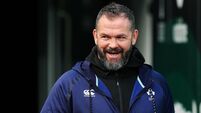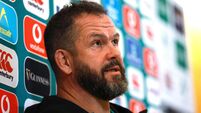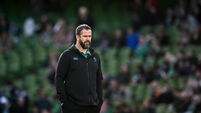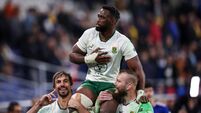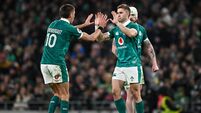Donal Lenihan: Back row battle crucial as Blackadder goes forth for All Blacks but it could be Doris’s day
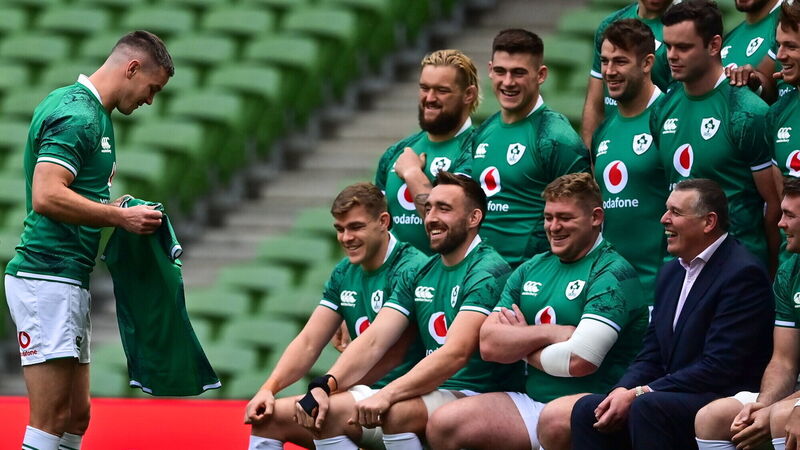
HAIL TO THE CHIEF: Ireland captain Jonathan Sexton makes a jersey presentation to outgoing IRFU chief executive Philip Browne before the captain’s run at Aviva Stadium.
International rugby’s latest centurions Beauden Barrett and Johnny Sexton, both having reached the 100th cap mark for their countries within a week of each other, are not only set to go head to head on Saturday but likely to prove the most influential performers on their respective teams.
When you consider three of Barrett’s caps came against the British and Irish Lions in 2017, Sexton, with six test caps for the Lions including that series, reached the magic number first. Then again, the New Zealander is six years younger and had to bide his time behind possibly the greatest No 10 of all time in Dan Carter before being handed the reins.
Having lost out to Richie Mo’unga for a time when he was switched to full back in a dual playmaking role, Barrett has won back the coveted No 10 shirt. After a brief sabbatical in Japan, he looks rejuvenated and has rediscovered his mojo.
After a full summer off, Sexton too is buzzing and looks even more animated than ever. That’s saying something. Against Japan he played flat to the line, enjoyed several touches in the same movement and was brilliant in identifying where the space was and then exploiting it. With both players in a rich form, their ability to direct traffic will be fascinating.
Sexton’s ability to control the tempo of this contest will come down solely to the availability of quick ball and the manner with which his forwards cope with the key breakdown battle. New Zealand always target this area, with and without the ball.
In contrast to Sexton, Barrett has pace to burn and always presents an individual scoring threat.
He too plays flat to the line, even more so when the opposition have the ball. Two intercept tries against Wales last time out showed just how sharp he is in reading what the opposition are about to launch. On the flip side, his tendency to shoot out of the defensive line may present Sexton with opportunities to create line breaks for others.
The fact that New Zealand are now blitzing in defence and applying force from the outside in will impose big pressure on Sexton’s ability to get the ball wide. As a consequence, his kicking game will be called upon far more than against Japan.
The problem here is New Zealand have already scored 13 tries against Tier 1 opponents this year when starting possession from a kick return. Therefore Ireland’s kicking game, across the board, will have to be spot on.
No jersey is more revered in New Zealand rugby than the black No 7 shirt. For years it was the starting point for any New Zealand selection. Pick a player of world-class to lead the charge at the breakdown and you were on your way.
Their three World Cup-winning sides of 1987, 2011, and 2015 had two such operators on board in Michael Jones and twice winning captain Richie McCaw. One of the primary reasons New Zealand broke a 24-year World Cup drought on home soil in 2011 was the fact that McCaw was flanked by Kieran Reid and Jerome Kaino in arguably the greatest back row unit to play at the international level.
It was no coincidence that this trio were still in harness when they retained the Webb Ellis trophy in Twickenham four years later. The back row has become the most influential unit on the field. The speed with which the ball is recycled at the breakdown has a major influence on how a team attacks and defends.
While never quite replacing McCaw — he was a one off — New Zealand have invested heavily in their back row depth since the shock defeat to England at the semi-final stage of the 2019 World Cup.
Ardie Savea is finally delivering on the promise he showed as a 20-year-old and was elevated to the captaincy in the absence of Sam Whitelock. Despite being a No 7 at heart, he has recently excelled from No 8 where coach Ian Foster feels he can get his hands on the ball more often and inflict even more damage.
New Zealand failed to replace Kaino by the time the 2019 World Cup rolled along while several of the current squad have been auditioning for a permanent shift in the No 6 jersey this season. It looked as if Akira Ioane had finally taken ownership of the shirt, having put in some monstrous displays throughout the Rugby Championship, but he’s being held back for an impact role off the bench in this one.
Stepping up from the start on Saturday is Ethan Blackadder, son of former All Black skipper Todd, who has performed well of late. Alongside him, another relative newcomer in Dalton Papalii starts on the open side ahead of recent captain Sam Cane, who doesn’t even make the bench. With just 19 caps between them, Blackadder and Papalii have a distance to go to reach the impact levels of their World Cup-winning predecessors.
Opposite them, Jack Conan has benefitted massively from the confidence gained by starting all three Lions tests in South Africa. He is now the senior man in Ireland’s breakaway trio and very much aware that if Ireland want to continue with the high tempo game they played last week, then they must find a way to master the emerging All Black trio.
Josh van der Flier is an open side very much in the New Zealand mould. His work rate is phenomenal, his ball carrying much improved and is also very explosive in the tackle. Andy Farrell has resisted the temptation to hand the No 6 shirt to Tadhg Beirne, holding him in reserve to work his turnover magic as a finisher.
That affords Caelan Doris the biggest challenge of his career. He has transitioned brilliantly to the international arena and would almost certainly have been a Lion had issues with concussion not ruled him out. Both back rows, while beautifully balanced, carry players relatively inexperienced at this level. Whoever adapts best will have a major influence on the outcome of this contest.
Every New Zealand team is populated with a number of players guaranteed a starting slot in any World XV selection. This one is no different with Brodie Retallick, Ardie Savea, and Beauden Barrett all standout performers.
Coupled with this, there is always some young buck on the rise, destined to light up the game for years to come. With 11 caps and 16 tries already under his belt, Will Jordan may not be viewed as a rookie by some but, in New Zealand terms, he still has a journey to travel.
From the moment he made his Crusaders debut as a 20-year-old, Jordan has perfected the art of turning try-scoring opportunities into points on the board.
His ability to kick and control the ball in full flight, without breaking stride, is incredible. The fact that, more often than not the ball bounces perfectly, right on cue into his grateful hands, is evidence that it doesn’t just happen by accident.
His acceleration from a standing start is incredible. You don’t realise how fast he’s travelling until you watch those trying to catch him. He just glides. The thing that separates him from other international wingers with proven finishing pace is his footballing skills. He makes everything look easy and, with more experience under his belt, is likely to end up in his favoured full back position by the time the World Cup rolls around.
Inside him in midfield on Saturday is another X factor player in Reiki Ioane whose made a very successful transition from the wing, where he debuted against the Lions in 2017, to outside centre.
He struggled for a while to cope with the pressure that comes with being a 20-year-old All Black but found a new lease of life when the Auckland Blues transferred him to outside centre.
That flexibility makes him invaluable to New Zealand. He often switches position off certain phase plays to maximise his size, aerial ability, and sheer pace. When New Zealand up the tempo and pile on the pressure in the final quarter of games, Jordan and Ioane are usually the beneficiaries.
For Ireland to win, not only do they have to carry a lead into that final quarter, they have to make sure those two brilliant broken field runners are starved of opportunities when fatigue becomes a factor in that period.

